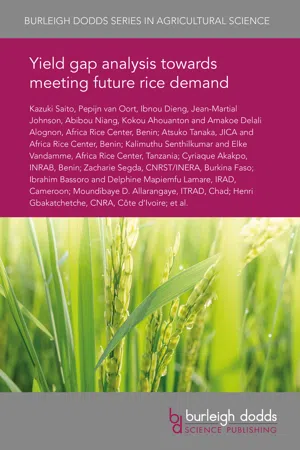
- English
- PDF
- Available on iOS & Android
Yield gap analysis towards meeting future rice demand
About this book
Rice provides 20% of the world’s food energy, and increased rice production owing to growing demand needs to be derived mainly from existing agricultural land. This requires reducing the ‘yield gap’, which is defined as the difference between potential yield and average on-farm yield obtained by farmers.
In this chapter, we provide case studies of yield gap analyses using different benchmarks (potential yield, experimental yield and best farmers’ yield) for estimating yield gaps. We start with studies focusing on the quantification of yield gaps and then describe studies with a focus on identification of the causes of yield gaps. We conclude with a discussion of the challenges to achieving better quantification of yield gaps and their causes, and the implications of yield gap studies for sustainable agricultural development to meet future rice demand.
Frequently asked questions
- Essential is ideal for learners and professionals who enjoy exploring a wide range of subjects. Access the Essential Library with 800,000+ trusted titles and best-sellers across business, personal growth, and the humanities. Includes unlimited reading time and Standard Read Aloud voice.
- Complete: Perfect for advanced learners and researchers needing full, unrestricted access. Unlock 1.4M+ books across hundreds of subjects, including academic and specialized titles. The Complete Plan also includes advanced features like Premium Read Aloud and Research Assistant.
Please note we cannot support devices running on iOS 13 and Android 7 or earlier. Learn more about using the app.
Information
Table of contents
- 1 Introduction
- 2 Studies on quantification of yield gaps
- 3 Studies to identify causes of yield gaps
- 4 Future trends and conclusion
- 5 Where to look for further information
- 6 References